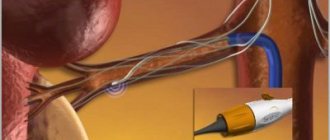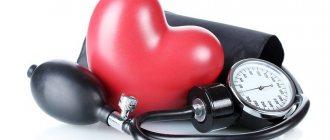Causes of diseases
According to statistics, hypertension is much more common than hypotension. A number of factors can lead to its occurrence:
- disorders of the nervous system (regular stress, depression);
- abuse of alcohol and tobacco products;
- unbalanced diet (frequent consumption of salty, fried and fatty foods);
- abnormalities of the endocrine system (obesity);
- increased physical activity;
- genetic predisposition;
- the occurrence of atherosclerotic lesions of the arteries.
Hypotonic disease can develop as a result of the following reasons:
- serious disturbances in the functioning of the cardiovascular system (for example, heart failure);
- infectious blood diseases (sepsis);
- lack of vitamins in the body;
- disturbances in the functioning of the digestive system;
- vegetative-vascular dystonia (VSD);
- decreased vascular tone (in particular, anaphylactic shock);
- change of usual climatic conditions.
Hypotension and hypertension
Types of hypertension
There are 2 types of hypertension - primary and secondary.
A disorder in which an increase in blood pressure occurs exclusively as part of hypertension is called primary hypertension. It is typical for 95% of all patients suffering from high blood pressure. Secondary or symptomatic hypertension is associated with other diseases. Among them:
- kidney inflammation;
- vascular disorders;
- atherosclerosis;
- pathologies of the adrenal glands, pituitary gland, pancreas.
Neurogenic hypertension, formed as a result of neuroses, also occurs. Secondary hypertension often becomes the only manifestation of a hidden disease. Diagnostics helps to identify the true cause and prescribe treatment. It does not involve normalizing blood pressure, but rather influencing the underlying disease.
Features of hypotension
A decrease in blood pressure occurs with high body temperature, significant blood loss, and poor nutrition. Less commonly, hypotension indicates serious diseases - anemia, hormonal disorders. The condition is less dangerous than hypertension and is considered normal for people of asthenic physique.
A dangerous form is acute hypotension, in which severe oxygen starvation of the brain occurs. The man loses consciousness. In this condition there is a high risk of stroke. Acute hypotension is caused by serious diseases - vascular thromboembolism, myocardial infarction, anaphylactic shock. A sharp drop in pressure also occurs during poisoning, dehydration, or blood poisoning.
Chronic hypotension is manifested by periodic headaches and dizziness, especially when moving from a sitting position to an upright position. A sharp drop in pressure causes fainting.
There are also primary and secondary hypotension. The first type is formed as a result of prolonged psycho-emotional stress - stress, depression. It occurs more often in young adults and adolescents.
The secondary form becomes a symptom accompanying complex diseases. Among them:
- cardiovascular diseases;
- cervical osteochondrosis;
- endocrine diseases;
- circulatory disorders;
- brain injuries.
Hypotonic people do not tolerate heat and prolonged periods without movement. Feeling better with physical activity - walking, swimming, etc. Strong tea, coffee, and tonic herbs help maintain normal blood pressure.
Edited: November 30, 2021
Author
Vybornova Irina Anatolyevna
About the author Sources Obstetrician-gynecologist, endocrinologist, candidate of medical sciences, specialist in intimate rehabilitation, complex vulvo-vaginal laser remodeling..
Dear women, I have been dealing with the diagnosis and treatment of infertility for many years and I can say with confidence that this terrible diagnosis for every woman no longer sounds like a death sentence.
A woman’s reproductive health and her opportunity to experience the incomparable happiness of motherhood depends on the quality provided by me and other specialists of our information center!
Test source
Reviewer
Basov Pavel Igorevich
About the reviewer Neurologist, Reflexotherapist, Hirudotherapist. Doctor of the highest qualification category. Medical experience over 15 years.
Proficient in all modern methods of diagnosing and treating patients with neurological pathology, including performing medical paravertebral blockades, therapeutic mesotherapy of the spine, shock wave therapy, botulinum therapy, and plasma therapy.
He has extensive experience in treating patients with vascular pathology of the brain, hernias and protrusions of intervertebral discs, and autonomic disorders.
Symptoms and signs of diseases
In the initial stages, symptoms of the disease may show virtually no symptoms. It has been noted that hypertension is much worse compared to hypotension, although some symptoms may be similar. Let's look at the most common symptoms characteristic of each disease separately.
Hypertension:
- Frequent headaches (migraines).
- Darkening of the eyes, “floaters” before the eyes.
- Rapid heartbeat (often accompanied by tingling and pain in the chest area).
- Congestion of the ears, the appearance of noise in them.
- Difficulty breathing (shortness of breath).
- Facial redness.
- Increased sweating of the palms and other parts of the body.
Hypotension:
- Pale skin.
- Loss of consciousness.
- Throbbing headache in the temples.
- Increased fatigue.
- Unstable emotional state (irritability, apathy).
- Feelings of nausea occur.
- General weakness and malaise of the body.
It is not recommended to ignore the above symptoms. A timely visit to a cardiologist will allow you to identify the disease at an early stage and prescribe the most appropriate treatment.
What is normal pressure?
The World Health Organization has compiled a special table that can be used to determine how normal your blood pressure is. Please note: “optimal pressure” is an indicator at which the risk of developing cardiovascular diseases is practically absent.
| Blood pressure category | Systolic (upper) blood pressure mm Hg. Art. | Diastolic (lower) blood pressure mm Hg. Art. |
| Norm | ||
| Optimal | Less than 120 | Less than 80 |
| Normal | Less than 130 | Less than 85 |
| Increased normal | 130–139 | 85–89 |
| Hypertension | ||
| 1st degree (transient) | 140–159 | 90–99 |
| 2nd degree (moderate) | 160–179 | 100–109 |
| 3rd degree (severe) | More than 180 | More than 110 |
| Border | 140–149 | Less than 90 |
| Isolated systolic hypertension | More than 140 | Less than 90 |
Which disease is more dangerous?
Both diseases are dangerous for humans and, in the absence of timely treatment, can lead to a number of negative consequences. Hypertension is accompanied by impaired blood supply to tissues and internal organs. As a result of this, the muscular organ functions with increased load, and a compensatory increase occurs. This can lead to the following ailments: decreased vision, poor circulation, the development of coronary heart disease and acute renal failure.
Hypotension significantly reduces the level of quality of life and seriously affects ability to work. If it continues for a long time, the patient may begin bleeding from internal organs and develop diseases of the endocrine system (for example, hypothyroidism).
Publication date: 04/25/2018 14:24:06
Weather against blood vessels
The fact that meteosensitivity is the first sign of an abnormal pressure level is not a myth, but a real proven fact. You probably yourself have noticed that any change in the weather (it doesn’t matter whether it’s a cold snap or, conversely, a thaw) entails a deterioration in well-being, headaches, and weakness. Meanwhile, doctors have recorded that strokes, heart attacks, and heart attacks occur precisely when weather conditions change. What is the pattern of interaction between us and the planet’s atmosphere? It's simple.
Article on the topic
What causes high blood pressure? 7 facts about hypertension
In hot weather, a lot of water evaporates from the body, and accordingly the density of the blood increases and it thickens. Cold provokes vascular spasms, and as a result - poor circulation. In any case, the heart begins to work with increased tension, which leads to a change in blood pressure. And this causes vascular overstrain. And if the vessels are sick and unstable to external influences, hemorrhage can occur, that is, a stroke.
Myths and facts about blood pressure
In case of any blood pressure disorders, it is necessary to check the thyroid gland. This is true. The thyroid gland, although small, is a very hardworking organ. And even when it fails, you may not always feel it right away. Meanwhile, the lack of its hormones affects the functioning of the heart and can cause a slowdown in its rhythm (less than 60 beats per minute), heart failure, and lower or increase blood pressure.
Instead of doctors, you can seek advice from “experienced hypertensive patients” - they will tell you how to quickly lower your blood pressure. This is the wrong way of thinking. There are more than six different groups of antihypertensive (i.e., blood pressure-lowering) drugs. And each group has its own indications and contraindications for use. Even within the same group, drugs vary greatly in their properties and are selected individually, depending on the dynamics of blood pressure fluctuations, concomitant diseases and the general condition of the person.
Treatment of hypertension leads to impotence in men. This statement is not unfounded. Some drugs designed to treat hypertension cause decreased sexual function. But, firstly, they only reduce libido and have no effect on erectile functions. And secondly, even for such an effect a very long course is needed.
Don't bog me down with statistics!
40% men and 41% of women in Russia suffer from high blood pressure.
45% premature deaths occur due to strokes and heart attacks caused by hypertension. That is, almost every second person in Russia dies due to diseases that began with just high blood pressure.
12% of men and 25% of women after 45 years of age are interested in their blood pressure and measure it regularly, the rest simply do not pay attention to the alarming symptoms.
Diagnostics
Hypotension can turn into hypertension, despite the fact that blood pressure levels and symptoms of these pathologies differ significantly.
The following methods are used to make a diagnosis:
- Anamnesis collection. The doctor asks the patient about his usual state of health and takes into account all the person’s complaints.
- Blood pressure measurement. The indicator is checked at intervals of several minutes. It is important that the patient independently monitors blood pressure and has an idea of the indicators characteristic of poor and good health. Each person has an individual blood pressure level.
- Blood chemistry. The amount of cholesterol, glucose, lipid fractions, and electrolyte levels are determined.
- ECG. It is carried out at rest and after exercise.
- Echocardiography, electroencephalography.
- A consultation with a cardiologist, neurologist, and endocrinologist is carried out.
Where does hypertension lead?
“Hypertension” is translated from Greek as “overtension.” This term most often refers to an increase in blood pressure, which inevitably leads to hypertension.
The approach of hypertension is characterized by weather sensitivity, drowsiness, and weakness when the weather changes. Over time, hypertension threatens to move into a more serious phase, in which there is a deficiency of hormones that regulate the state of the vascular system. That is, the body will completely stop coping with even small temperature changes. The appearance of hypertension can also be preceded by kidney disease, a hereditary factor, age-related changes in blood vessels, and endocrine disorders during menopause.
What are these diseases?
To ensure normal functioning of the human body, blood pressure must be at a certain level. If this indicator changes significantly, the body dies. Blood pressure fluctuates as a result of physical activity, meteorological changes, stress, etc. To prevent these factors from harming a person, the body uses complex mechanisms to maintain blood pressure at the same level. If the operation of these mechanisms is disrupted, then a person’s blood pressure deviates significantly upward or downward. A stable deviation of blood pressure indicators in the upward direction is called arterial hypertension (hypertension), and in the downward direction - hypotension (hypotension). At the same time, pressure indicators are strictly individual. What is normal for one person is a hypertensive crisis for another.
Enter your pressure
Move the sliders
120
on
80










